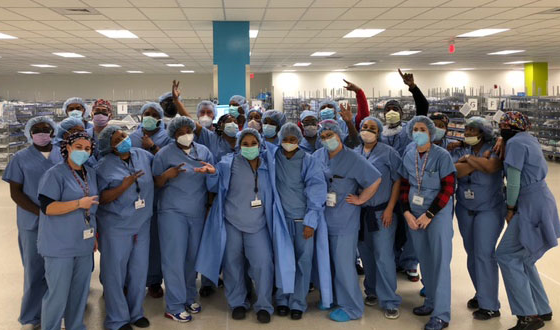When we watch shows like “ER,” “Grey’s Anatomy,” “House,” and “M*A*S*H,” the action in the operating room is usually front and center — indicated by the swell of dramatic music and emotional closeups. Clad in surgical gowns, caps, gloves, masks, and other personal protective equipment, the TV surgeon turns to their tray of glistening tools before embarking on the life or death procedure.
But did you ever wonder how those critical pieces of equipment — such as scalpels, scissors, forceps, and clamps — actually make it to the tray cleaned, sterilized, picked, and ready for the task at hand? In real life, surgeons and patients depend on the skill and expertise of the sterile processing technician.
In early February, Penn Medicine opened its new Interventional Support Center (ISC), the largest instrument processing and surgical supply preparation facility in the country. It is also the first facility of its kind in Pennsylvania. In this space, technicians sterilize and package thousands of instruments each day in preparation for surgeries and procedures — from basic scissors and clamps to advanced robotic instruments.
And at nearly 110,000 square feet, the ISC is designed to process instruments from up to 200 surgical cases each day. “The opening of this facility is a testament to the sterile processing technician role and the importance of the work they do,” said Carolyn Grous, RN, director of PeriOperative Services Compliance at the Hospital of the University of Pennsylvania (HUP). Grous, who has been with Penn Medicine for more than 40 years, can attest to the evolution of the role, the critical requirements to become a technician, and the fact that the ISC is designed with the technician in mind.
In order to become a sterile processing technician there is significant rigor and training involved including a required certification program. Certification is achieved through a combination of work experience and successful completion of an examination administered through the Certification Board for Sterile Processing and Distribution (CBSPD) or the International Association of Healthcare Central Service Materiel Management (IAHCSMM).
So why is working at a place like the ISC so exciting? What exactly is a day in the life like for a sterile processing technician? After all, these technicians are at the heart of health care quality and safety, and many depend on them to get a very critical job done.
Angelica McCoy, a sterile processing technician, is part of the inaugural team working at the new ISC. She’s been working as a technician for almost two years — the same amount of time she has been with Penn Medicine. McCoy came into the profession by way of a friend and realized very quickly how vital the technician was to the healthcare industry. “Every day welcomes an opportunity to learn something new that will help our patients,” McCoy shared.
A typical day for McCoy begins with going to the locker room to change into her sterile scrub set and hair covering. She puts on on the proper footwear so she can comfortably traverse different areas of the facility. (Did we mention it’s nearly 110,000 square feet?) After donning her gear, she attends a daily huddle to determine her assignment and hear about the priority for the day — sometimes it’s making sure sets for the next day’s cases are ready and sometimes it’s making sure they have enough sets on the shelf to pick in case of an emergency.
At the conclusion of the huddle, McCoy heads over to her workstation and makes sure it is stocked for the day. McCoy has everything she needs right at her fingertips, including a printer, so she can identify the set and its contents. The rest of the day changes based on her assignment. One advantage of the ISC is that technicians are able to focus on the task at hand and experience fewer interruptions. Right now, McCoy is in assembly, so her day consists of assembling instrument sets that will eventually be loaded onto case carts and shipped to HUP, Pennsylvania Hospital (PAH), or one of the outpatient facilities the currently ISC supports — the Perelman Center and the Ambulatory Surgery Center at Rittenhouse. The Pavilion (also known as HUP East) will join that list when it opens later this year.

From the case carts to the instrument trays, the innovative and state-of-the-art equipment at the ISC helps reduce physical stress on the body. For example, the wash sinks used to initially soak the instruments (and the first step in the decontamination process) are height adjustable, which allow the staff to work in safe comfortable postures.
Since starting at the ISC, the generous amount of space is something McCoy is relishing. Not only is there plenty of space for each technician — an important element with social distancing during the pandemic — now all technicians are working at one place, as a team. Prior to the ISC’s opening, technicians worked in smaller teams at each hospital and outpatient clinic. “It’s nice to have everyone in the same space. Our sterilization team is right within the department, it’s a wonderful setup,” she said.
McCoy is not alone in her enthusiasm for the new facility. “The energy and collaboration are very high with the recent transition from Pennsy and the HUP,” said Shannon Camps, MS, PHR, SHRM-CP, employee relations and retention specialist for the ISC. “It’s remarkable to see how both cultures have come together to form a new culture for the ISC and employees are highly engaged.”
The sterile processing team had to learn how to assemble sets for other entities (other than the one they transitioned from) when they moved to the ISC but there is a sense of teamwork, so McCoy knows she can ask her peers for help. Having a nice set being put together gives her a feeling of accomplishment. “Before I finish assembling, I say a prayer for the recipient of the set,” said McCoy. “There is a face to every set I assemble.”